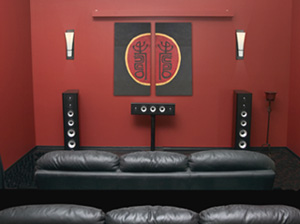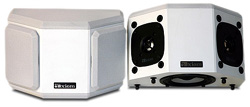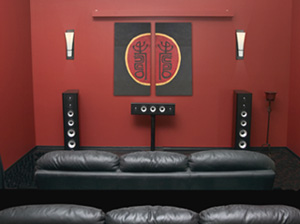1. Buy Blackout Curtains to Darken the Room for Optimal Picture Quality
If you are watching front projection images on a large separate screen and there is light in the room, you won't believe how much better your big-screen images will look—snappier contrast, blacker blacks and richer colors-- once you truly darken the room with blackout curtains. You can find them at places like Home Depot and they are inexpensive, available in several colors, and made from a velvet-like micro-fiber that shuts out all the light.
When ambient light falls on a projection screen, it washes out shadow and black areas, reduces contrast and apparent color saturation. “Black” in video terms is an absence of light. The pixels in the video device turn off and stop producing light or, in the case of an LCD front or rear projector, stop letting light pass through the LCD panel. A front projector's light output thrown across a room is much less than a rear-projection DLP, LCD or LCoS set, but even those sets will benefit from a significant reduction of extraneous room light.
2. Use the “Cinema” Brightness Setting for Serious Viewing
Owners of DLP or LCD rear-projection HDTVs may have noted their sets have several possible pre-set brightness settings (the brightest mode is usually reserved for demos in fluorescent-lit stores). In nearly all cases, you'll get the finest gradation of colors, skin tones and black levels when you choose the “Cinema” or dimmest mode. (This assumes you've already installed window coverings or blackout curtains to reduce ambient room light.) The projector bulb will also last longer when it's run at its dimmer setting.
3. Shop for more Comfortable Seating: Consider Dedicated Home Theater Chair

Don't make it too comfortable or you or your guests may doze off mid-movie, which is always embarrassing. But if, like me, you have an aging couch with sagging springs that prove to be uncomfortable after a one-hour program, then it's time to upgrade. It's the type of item that's likely been on your list for some time but you never quite get around to it. Do it. Besides, when the lights are up, you'll still have some great seating to collapse into at the end of a long day.
4. Upgrade the Center-Channel Speaker to Improve Dialogue Clarity and/or the Surround Speakers for Greater Effects Envelopment
We often cobble together a home theater system using an old bookshelf speaker of a different brand as the center. It's easy to become accustomed to the colorations that may exist because it's from a different maker and much older technology than your main speakers. But those colorations, tonal mismatches and lack of detail are what inhibit dialog clarity. If you've had trouble understanding dialog in DVD movies and TV shows, you'll get immediate improvement with a new center-channel speaker that has the same detailed, clear and transparent sound quality of your left and right front speakers.
Poor dialogue clarity may also result from a subwoofer that's turned up too loud. Powerful low bass at too loud levels has a tendency to flood the room with standing waves that overwhelm intelligibility, muddying up the dialogue and imaging. Balance is the key to a great bass experience: deep bass should form a foundation for great home theater sound but not dominate it.

Multi-directional QS4 Surround Speakers shown in Eggshell White
The closer the tonal match between the center channel, main left and right, and surrounds, the better your overall experience will be. Likewise, you may have used some older speakers from days gone by as “temporary” surrounds. Speaker technology improves on average every five years and great strides have been made in dedicated multi-polar surrounds that mimic the envelopment in effects you experience in a big cinema. So replace those aging surrounds with a dedicated effects speaker, preferably one that uses multiple drivers to enhance envelopment for all the viewers no matter where they sit. Adding two extra surrounds for 7.1 channels will also improve the sense of viewer envelopment and involvement.
5. Get Home Theater Speakers and 3-D Sound Quality that Match Your High Definition Video Display by Retiring that HTIB System
If you've been “making do” with that so-so Home-Theater-in-a-Box system and you've just gotten a new HDTV display, you've likely found that the sound quality no longer matches the stunning HDTV video images. It's time to retire the HTIB to a bedroom and get a really excellent dedicated 5.1- or 7.1-channel speaker system that delivers a high-fidelity three-dimensional audio presentation fully the equal of your big-screen HDTV display. You needn't do it all at once, either. Start with some high-quality front and center speakers, adding the surrounds and then a powerful subwoofer as your budget permits.
.1: Upgrade or Add a Powerful Subwoofer for Enhanced Movie and Music Enjoyment
Just like using some old speakers as a center or surrounds (see above), making do with a tiny bargain basement sub just won't cut it with your new big-screen display and high-quality main speakers. You may even have stopped noticing the one-note boom of the bass module. But you'll experience a real kick if you scale up the quality of the low bass effects with a powerful subwoofer. After all, Dolby and dts dedicate a low-frequency effects channel just for deep bass effects—and advances in technology like modern DSP-powered subwoofers (eg. Axiom's EP500 and EP600 subwoofers) will excavate bass far lower than ever before. Sure, make do with the old sub for a while if you want, but prepare for a dynamic lift in performance when you fire up a great, dedicated subwoofer.
Dept. of Cheap Thrills:
Those who would like a truly “moving” experience but don't want to annoy the neighbors or wake the kids may want to consider adding butt kickers or bass shakers to some of their home theater seats. While it's no substitute for real deep bass from a big subwoofer, a bass shaker is a tactile transducer, powered, that installs beneath the seating portion of a home theater seat and connects to a speaker or subwoofer output from your receiver/amplifier. The device tracks the low-frequency effects and vibrates accordingly, giving seated viewers a physical buzz. No sound is emitted. Prices for bass shakers start at around $200.






